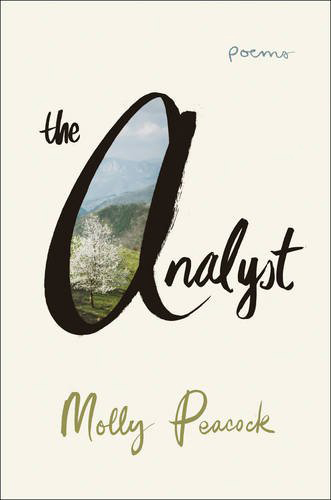The Analyst
The person referenced in the title and pages of Molly Peacock’s book of poetry The Analyst is Joan Workman Stein, a New York practitioner who had a stroke in 2012 and later was able to resume her love of painting. Over a span of close to 40 years, the initial therapist-patient relationship between Peacock and Stein became a close and enduring friendship.
The person referenced in the title and pages of Molly Peacock’s book of poetry The Analyst is Joan Workman Stein, a New York practitioner who had a stroke in 2012 and later was able to resume her love of painting. Over a span of close to 40 years, the initial therapist-patient relationship between Peacock and Stein became a close and enduring friendship.
Peacock’s decision to seek counseling in the first place was precipitated by some chaotic family events during her developing years and experiences in her young adult life, all of which she touched on in a blog post on Partisan in June.
Peacock’s devotion to her analyst is strongly worded in her book’s initial poem, “Gusto,” written when she didn’t expect her friend to live:
I want to die, to help you.
[ . . . ] hemorrhaging in the brain
a malformation that had lain in wait
seventy-seven years for you, supine,
slumped in your watercolor class.
In “Life, Lightened” Peacock portrays her analysist before the stroke:
Like a runaway artist, you used to flee
your patients’ modern anguish at home
to stroll along the ochre squares of Rome,
to sketch a yellow leaf, a tawny hound,
to see unvarnished color with free eyes
far from our jaundiced complaints,
And juxtaposes with after:
[ . . . ] your attendant
guides you up the elevator that
we, your patients, rode [ . . . ] you approach your door with
yellow mimosa that you’ll paint, after
you unlock it, having learned
to use keys again, holding
both hands to twist the cylinder.
Not all of the volume is focused solely on the analyst. A long, four-part work titled “A Fall in the Fall” tells about the speaker—I’m assuming it’s Peacock—falling on a wet flight of stairs. Her husband takes the role of caregiver while she recovers. Here’s where she writes what I think is one of the most marvelously worded passages in the book:
Of course we married each other to parent each other.
Our poor parents tried, but they slipped
and tossed us both up in the air.
The minute we left their hands we began
grasping for one another even though
we hadn’t even seen a speck of each other in the distance yet.
Another incident calls for a trip to the hospital, resulting in the cringe inducing poem “Stirrups in the Emergency Room”:
She leaves me in a windowless room for an hour
(you can abstain from sex, but not from pain)
and returns without a test result or referral
or even a topical cream. Do not scream.
Of course, the primary focus of the book is the analyst, who comes into play as a shadow in two poems. First in “Shadow”:
A shadow behind me not my shadow
for it clings exactly to my back’s back,
curls with me in the bed, alights with me
as I get up, crawls completely over
my shoulder to watch the meadow of things
I’ve laid for breakfast drift across the table.
Second in “Seeing is a Meal in Itself,” which takes place at an auction gallery:
When I think, I wish you could see this, you
leap out and double my shadow with your own.
[ . . . ] We flee through
the glass door triumphantly buying nothing,
and you fall back asleep beneath my skin.
I perceived lines in “How to Say ‘Thank You’ in French” to be a poetic memoir addressing the analyst with nine ways to say thank you. Each section begins with a wikiHow instruction and is followed by Peacock’s response. Examples of her responses: “Merci madame for not raising your eyebrows at mon monsieur, / spécialement when I declare, / ‘I think I’m going to get married again,’” “Now that you have become stranger and elder after / your terrible stroke, I use vous. Formal, no?” and “For my second chance, merci. / Later you will call and repeat, ‘How lucky I am.’ / J’ai de la chance, you say. / And I say, J’ai de la chance, back to you.”
Granted, The Analyst has an undeniably narrow focus, and your first inclination might be to pass on it. But instead, why not add it to your post-holiday reading list when it’s on the shelves in January. You’ll find a heartfelt and impressive exploration of the notion and moods of friendship.





